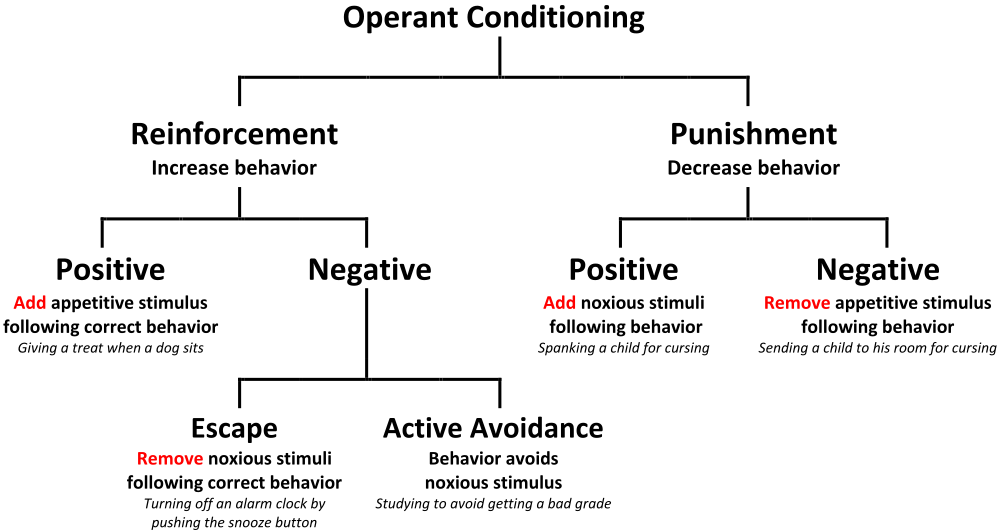You’ve probably heard terms like “negative reinforcement” and “positive reinforcement” thrown around a lot during the course of your parenting career. And although the concepts of “reinforcement” and “punishment” are related in that they can influence your child’s behavior, they go about it in different ways — and with different results.
[RELATED: “Positive Punishment: Using Consequences to Change Your Child’s Behavior“]
If you decide to try out either — or both — of these parenting techniques, it’s important that you first understand what they mean, what they do, and how you can incorporate this technique into your parenting style — and how your babysitter or nanny can incorporate it into their child care repertoire.
For now, we’ll focus on the concept of “negative reinforcement.”
What Is “Reinforcement”?
At a high level, “reinforcement” is a process by which you encourage a particular behavior so that it happens more frequently in the future.
This concept was first introduced by B.F. Skinner, a behavioral psychologist who developed a theory of learning known as “operant conditioning.” This theory asserts that we learn “good” and “bad” behaviors by creating associations between a behavior and the consequence(s) of that behavior. By adding or subtracting favorable or unfavorable consequences, you can then strengthen the behaviors you want (also known as “reinforcement”), and eliminate the behaviors you don’t (also known as “punishment”).
There are two ways to go about encouraging — or reinforcing — certain behaviors that your child does. One way to do this is by presenting them with a motivating or desirable stimulus (e.g., praise) after they perform the behavior you want to see (e.g., cleaning their room). Another way to do this is by removing some aversive or undesirable stimulus (e.g., nagging) after they perform the behavior you want to encourage (e.g., doing their homework). These two tactics are referred to as “positive reinforcement” and “negative reinforcement,” respectively.
For the purposes of this article, we’ll focus on explaining what “negative reinforcement” is and how you can implement it. If you’re interested in learning more about “positive reinforcement,” make sure to read our article, “6 Positive Reinforcement Examples to Try With Your Kids.”
What Is “Negative Reinforcement”?
Contrary to its name, “negative reinforcement” isn’t a bad thing. It’s important to note that — in the context of operant conditioning — “negative” and “positive” don’t mean “bad” or “good.” Rather, they refer to taking something away or adding something — respectively — as a way to influence a particular behavior.
As such, negative reinforcement is the idea that — instead of adding an unfavorable outcome to deter bad behavior (otherwise known as “punishment”) — you’re actually removing something unfavorable in order to encourage a good behavior.
What Is Negative Reinforcement as a Parenting Technique?
“When you use this procedure, you need to remember that it isn’t punishment,” says Corinna Bittle, a certified behavior analyst and owner of bitKIDS Behaviour Consulting. In other words, you’re not adding some kind of undesired outcome as a way to decrease a particular behavior. In fact, you’re doing the opposite: you’re removing a consequence they don’t like when they do something you want them to do.
“Instead,” Bittle adds, “it is removing something to increase a behavior. You are going to do things such as removing extra work. This will be in response to a behavior that you want to see more of, so you are reinforcing the behavior you want to see more of in the future.” Because negative reinforcement is a reinforcement strategy, there aren’t any real worries with implementing it.
“Negative reinforcement is best used in close proximity to the behavior,” says Amy Webb, who has a doctorate in human development and family sciences. Bittle agrees. “The trick with reinforcement is that you need to be able to figure out what your child wants and you need to make sure that you are giving it to them for those behaviors you want to see — not for the behaviors you want to reduce.”
Webb warns that there are instances that using negative reinforcement may accidentally give you the outcome you weren’t hoping for. “For example, a child whines and pouts when made to eat his vegetables, so the parents remove the vegetables from his plate. This just reinforces the child’s desire not to eat vegetables.” Negative reinforcement isn’t going to be appropriate in every situation.
How Do I Use Negative Reinforcement in Real Life?
It’s easier to understand when you see some actual examples of negative reinforcement in action. Here are four real-life scenarios you probably deal with every day in which you can use negative reinforcement to encourage more positive behaviors:
- Cleanup Struggle
Your child is doing a great job helping you clean up a puzzle. You say, “I love all of your help. Know what? I’ll finish cleaning up now.” You have just removed part of your child’s work (i.e., cleaning up the puzzle). In the future, your child is more likely to help you clean up because, when he does, you reward him by removing some of the work.While this is a great compromise to get your children to help you with some of the housework, they may soon rely on your leniency every time you ask them to do a chore. Reserve this reward for when you are doing a big task, or when they have been really helpful with the job at hand.
- Homework Boycott
We’ve all been there during the homework struggle. Your child doesn’t want to do their homework, so you nag them to just get it done. Then, a strange thing happens. They do their homework! Why? To get you to stop nagging. The nagging was negatively reinforcing the behavior of doing homework because your child wants to remove the negative stimulus — your nagging.
- Dinnertime Tantrums
To avoid a dinner time meltdown, you tell your child they may take five bites and then they are excused from the dinner table. At future dinners, they will know that you will allow them to get up from the table after eating five bites of their food, and you will avoid a tantrum.Even though you aren’t giving in to your child’s tantrum and removing the food altogether, they may soon jump right to the “five-bite rule” at every meal. You don’t want a mealtime battle the moment you set the food down on the table, so turn to the “five-bite rule” when you’re really struggling to get your child to eat their dinner.
- Bedtime Battles
You put your kiddo to bed, but he won’t stay there. To encourage him to stay put, you tell him that he doesn’t have to make the bed in the morning if he stays in bed. By removing a chore he hates (i.e., making the bed), you’re encouraging his good behavior (i.e., going to sleep on time).The next time your child wants to get out of bed, he will reconsider it — is it worth having to make the bed the next day? The key to making this example work is picking the right chore to remove for your child. If your little one loves making the bed, pick a different chore as incentive.
Originally written by Stephanie Glover. Updated by Kayla King and Katie Bonadies on 26 June 2017.






